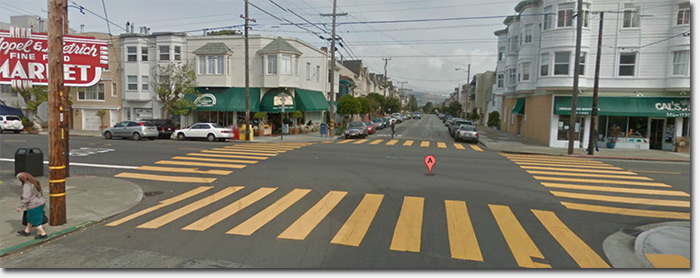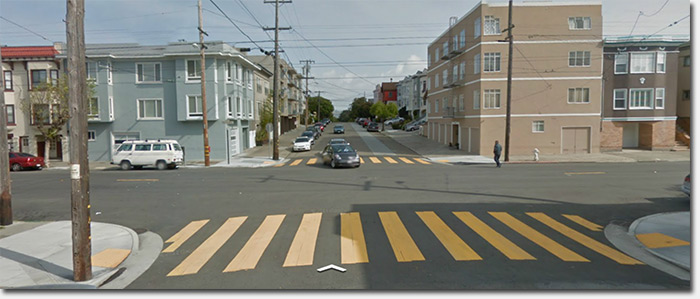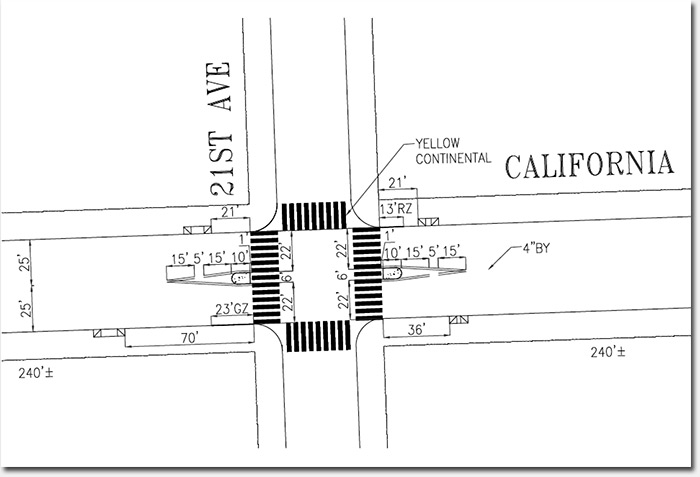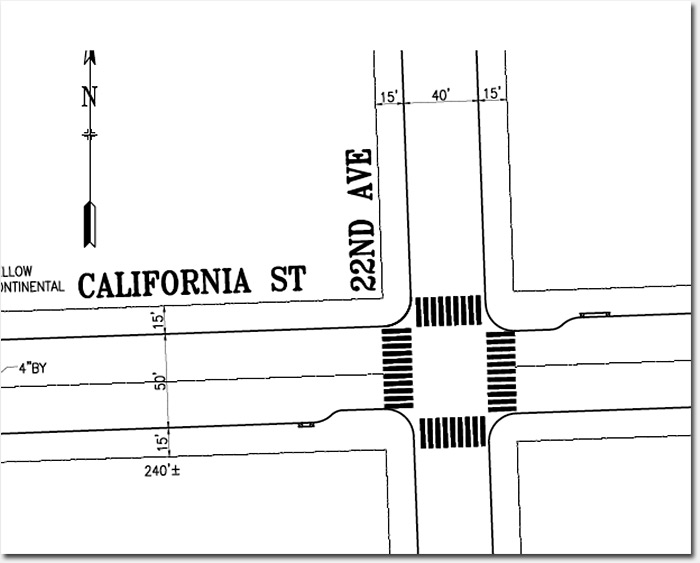
The intersection of 22nd and California, where sidewalk bulb-outs will be installed.
Well they aren’t traffic circles, thank goodness, but the SFMTA is planning to install additional traffic calming measures on California Street at 21st and 22nd Avenues.
These changes are part of a larger Central Richmond Traffic Calming Project (PDF) which has been underway since 2007. The project is designed to slow down traffic and increase pedestrian safety at designated intersections between Lake and Fulton, and 12th and 25th Avenues.
Once you cross Park Presidio on California Street heading west, the street becomes a favorite for drivers who are working their way to the outer avenues. That’s because there are very few stop signs – only a couple between 14th and 22nd Avenues.
To help slow down the cars coming through – without installing stop signs – the SFMTA is utilizing traffic islands (also known as median islands) and bulb-outs at intersections.
Traffic islands are planned for the intersection of 21st and California, which would extend out 45 feet in either direction from the intersection, tapering in width. The goal is that pedestrians would have a “safe harbour” as they cross the busy street, and as they wait, be up higher, and more visible to drivers who can stop to let them walk across. The cost for traffic medians range from $10,000 to $75,000 depending on their size.
At 22nd Avenue and California, which already has a stop sign, new bulb-outs will be installed at the bus stops on the northeast and southeast corners. Bulb-outs are designed to reduce the distance that pedestrians have to cross and make it easier for approaching vehicles to see pedestrians that are waiting to cross.
Buses will also have to negotiate the bulb-outs which means that when a bus is stopped to pick up passengers, there will be no getting around it. Bulb-outs also make it difficult for trucks to make right turns, which could be problematic for the many trucks that deliver to the market. The cost for a bulb-out? $50,000 to $150,000 each according to the SFMTA.
We’ve heard complaints about driver’s habits at the intersection of 22nd and California before. It’s a busy spot with the market on one side, Angelina’s on the other, 2 bus stops, and an elementary school on 22nd Avenue. Swing by there around 8am on a school day and it’s pretty crazy between the double parked cars, school kids being dropped off, and people grabbing their morning coffee.
A public hearing was held back on December 28, 2012 about these planned changes, and signs were posted on the utility poles at each intersection. However it’s likely that most residents, unless they happen to take MUNI, don’t know that these changes are in the works.
One neighbor who lives at 22nd and California, thinks the proposed traffic islands are not appropriate for the intersection.
“As a pedestrian, I would never stop on the island! Even with parking spots removed, it is still too narrow and will only direct the speeding cars closer to pedestrians as they go around. I don’t believe this will even remotely slow them down.”
Do you live near these intersections and use them regularly? Leave a comment to let us know what you think about these upcoming changes.
Sarah B.

The intersection of 21st and California where traffic medians will be installed.


Wow. I live on Clement Street between 22nd and 23rd avenues, take the 1 California from the eastbound stop on occasion, shop at the corner market, go to the coffee shop, AND I’m on the MTA CAC — and I didn’t know about these plans. I didn’t even know about the public meeting on Friday, December 28, 2012. Didn’t know!
I will certainly ask about this at the next MTA CAC meeting that I attend.
I’ll admit, I tend to like bulb outs — but would also like to see something done on the northwest corner where, people frequently pull in the crosswalk and jump out to get coffee or pick up their laundry, blocking pedestrians.
The traffic islands on Geary don’t significantly “calm” traffic as far as I can tell. All they seem to do is narrow the lanes, which is exactly what California doesn’t need. The only thing that really seems to affect drivers who speed and won’t stop for pedestrians at crosswalks is the occasional SFPD patrol car sitting and observing the intersections, particularly at 26th Avenue and farther west.
Double parked cars in front of the market and Angelina’s are the greatest source of congestion at California and 22nd. I almost wish they’d allow pedestrian dropoff in the sections reserved for bus stops, but I suspect the same people who double park in front of the shops will simply park and leave their cars in the bus stop zones.
That neon sign for the market is so retro, although it’s probably not retro by design; I imagine it’s been there for years. It reminds me of the neon sign that hung outside of the corner store my grandparents owned back when I was a young boy, too many years ago .
Sit on one of the benches at 22nd and Calfornia and see how many cars in a row don’t come to a complete Stop. I counted 10 in a row the other day. Writing a few tickets would hurt the situation.
Geary may not be the ‘calmest’ street– but imagine trying to cross if the medians weren’t there. It would be far worse.
What’s wrong with narrowing lanes? It’s not a freeway, and it doesn’t need freeway-standard lanes.
My only criticism is that this should be coordinated with those corner ramp reconstructions, so that the work isn’t done twice.
@Alai- Try riding a bicycle through one of the older neighborhoods like North Beach or Chinatown where some of the streets are so narrow it’s hard for a full-sized truck or SUV to pass through. Try “sharing” the road with one of those vehicles when you’re a cyclist.
California does not need narrower lanes or a traffic island. I’d prefer they’d put up traffic lights at the California & 22nd intersection. Drivers might be less apt to speed down the street if they knew there were two signal-controlled intersections, one at 25th Avenue and the other at 22nd.
The auto portion of California at this point is 50 feet wide– 16 feet for parking and 34 for two traffic lanes. That’s extremely wide– 17 feet per lane. All it does is encourage people to treat it like a freeway.
Narrow streets are great. Just look at Amsterdam (you can take a tour on Google Maps/Street View. 20 feet is wider than average there, and it’s a fantastic for biking. When streets are narrow, everyone has to go fairly slowly, so it’s easy to bike ahead of or behind other vehicles, whether cars or SUVs or trucks. If it’s hard for a truck to pass through, then they have to do it slowly and carefully, which is great for cyclists. Far better than being passed at 35 mph because you’re in your “own” 5 foot wide lane.
The downside of narrow streets in SF is that they don’t make a continuous network– you’re invariably spit right back out onto 40-60 foot wide streets with high speed traffic. In the Richmond, we have no narrow streets at all, to our detriment.
I don’t like the idea of putting traffic lights everywhere. Not only is it a waste of resources (they’re much more expensive than medians are, especially considering the operating costs), it leads to a 0-35-0-35 mph speed pattern that is dangerous and is not even any faster for drivers than a constant 20 mph would be. It requires people to wait for nonexistent cross traffic, and then fly through the intersection where there’s no control device.
Better to limit speeds, require yielding, and enforce both. Islands help in this regard.
@Alai- This isn’t Amsterdam, this is San Francisco in California, where drivers feel entitled to run down anyone who’s not a car. I’ve been clipped by sideview mirrors as motorists push their way through a street lined with cars, including double parked delivery and service vehicles. Passing a moving truck on a narrow street is a scary experience, IMO, because there’s so little room to get out of the way in the event the truck suddenly swerves to avoid getting doored or to get around another large vehicle. I also don’t see many CA drivers going “a constant 20” (really?), not even around school zones.
What I like about the wider streets in the Richmond is that they allow more light and air to enter residences and businesses, and it is possible for cyclists, especially older, slower ones like myself to ride the streets in relative safety. I regularly ride down Clement and California to get into the more central parts of the city, and it is pleasant and safer compared to the darker, more narrower streets going through North Beach, the Haight and other older neighborhoods.
Please tell me how traffic islands will “enforce” speed limits and require yielding. “Enforce” requires the active and aggressive pursuit of violators, something I don’t see a piece of concrete doing.
So this: http://goo.gl/maps/5iCQl
is nicer/safer to ride on than this: http://goo.gl/maps/Ha29D ?
Traffic islands don’t enforce speeds, they limit them. Drivers can (and do) ignore stop signs, but they can’t ignore a curb.
If you want to compare, go to the Duboce Triangle where traffic calming measures were installed in the 70s. Nice wide sidewalks, shorter street crossings, large trees, benches, etc. Now go to the Richmond where the same traffic calming measures were proposed in the 70s but rejected by residents – wide street crossings, speeding, few trees, pretty barren. If you truly prefer the latter, keep complaining about these changes.
@bicyclesalad: Whoa! Someone’s going to move the buildings closer together?!?
Enough with that BS already, Plastic bag ban, traffic circles, endless stop sings…. They are making everything they can to make living hard in this city.
@SFer: The Outer Richmond has “nice wide sidewalks.” We also have “large trees,” albeit they’re not growing in the middle of the street. 😛 And if you look at the plan posted above, there’s no mention of widening the sidewalks or planting trees. They’re installing concrete bulb-outs, which will be right in front of the bus stops on California and 22nd and a traffic island at the 21st Avenue intersection. No park-like roundabouts, no trees, no benches, no promenades. I foresee more congestion if cars can’t pass paused buses at the stop, though I can see it becoming more safer for passengers getting off there, since cars can’t get through the intersection until the bus takes off.
I will admit, I would like it if the city would consider installing planted boulevards between the west and eastbound lanes on Geary. My work sent me to Sacramento today, and I really liked the islands planted with trees, shrubbery, and flower beds. The plants aren’t very helpful to pedestrians trying to stand on the islands as they cross the streets, but they add some appreciated greenspace, which we could always use more of.
i live at the corner or 21st and California. Before placing cement “islands” in the middle of the street, why not try painting a cross-walk there? (across California). Yes, cars are supposed to stop for pedestrians. But without an actual crosswalk painted there, some of the drivers look confused. Should I stop? Is this a crosswalk? Is that guy going to cross? Some of the people crossing there look confused, too. Should I walk? Is this a crosswalk? Is that car going to stop? It’s the hesitation and uncertainty that makes it dangerous. Maybe putting an actual crosswalk there would help. Hate to see more cement, if it could be helped.
“$10,000 to $75,000”
$10,000…to $75,000…for…concrete…
This should help, but I worry it won’t have an impact. I almost would prefer big bumps at the intersection to force drivers to stop or at least really slow down. I agree with Mike – no one stops. I’m surprised no one has been hit crossing for Alamo School. My wife had many close calls while walking our son to and from school. It’s even more anarchy at the intersection when the crossing guard isn’t on duty.
The problem with big bumps is that they are apparently a bear for people with spinal injuries to go over when they are in Paratransit.
I’ve been nearly murdered, countless times crossing California at 22nd by drivers who see me, deliberately speed up and drive directly at me and my child while we’re in the cross walk even though they are required by law to stop at the stop sign! I’m not sure that restricting the lanes with even a narrow concrete island will help because it wont stop the drivers who run the stop signs every day or roll through the stop signs as they’re turning the corners.
The other significant traffic problem at this intersection is the absurd number of selfish people who think it’s acceptable to double and triple park their giant SUV’s alongside Angelina’s and the corner market. Not only does this create a traffic hazard for people turning the corners or trying to drive through the neighborhood but it creates a hazard for both drivers and pedestrians trying to cross the street by creating numerous blind spots.
AFTER THE MEETING IN DECEMBER OF 2012, THE MTA HAS ALREADY APPROVED THIS AND IT IS IN THE DEVELOPMENT STAGE. IF YOU DO NOT WANT THESE ISLANDS TO BE INSTALLED PERHAPS VOICING YOUR OPINION TO ERIC MAR OR THE MTA WOULD BE APPROPRIATE AT THIS POINT. These changes are going forward unless they are stopped now!
At the corner of 21st and California WE WILL BE LOOSING AT LEAST 3-4 PARKING SPOTS TO MAKE ROOM for people to speed towards the pedestrians on the sidewalk in order to go around the island. I am already circling for 15-20 min looking for parking. These are valuable parking spots and should not be removed!
I vote for a stop sign and a cross walk at 21st and California. Significantly cheaper to install and significantly more effective! The use of cement islands at 21st is not safe! It just places the pedestrians even closer to the cars zooming by. How are the buses on California supposed to go around this island? If not speed bumps how about something that chatters that the buses could go over without much notice but someone in their very expensive car might think twice about speeding over.
Or, earn money for the City by having regular traffic patrol motorcycles or squad cars on California and Lake Street on a more regular basis to let people in the District know that the City is serious about keeping speeding down and the importance of pedestrian safety.